Transport Planner Matthew Oxby, from our Strategic Rail team, looks at how the recent heatwave has put a sharper focus on the need for a more resilient rail network.
Pavements too hot for dogs to walk on, roads melting – and rails and platforms literally buckling in the heat. These are just some of the problems Britain and many parts of Europe have faced this week as record temperatures scorched the earth, cost lives, and spread challenge upon challenge.
Met Office climate attribution scientist, Dr Nikos Christidis, told the BBC this week “the chances of seeing 40°C days in the UK could be as much as 10 times more likely in the current climate than under a natural climate unaffected by human influence”.
Tuesday’s temperature predictions looked more like what is being predicted for 2050 than what we could reasonably have expected in 2022.
In 2020, the @metoffice produced a hypothetical weather forecast for 23 July 2050 based on UK climate projections.
Today, the forecast for Tuesday is shockingly almost identical for large parts of the country. pic.twitter.com/U5hQhZwoTi
— Dr Simon Lee (@SimonLeeWx) July 15, 2022
The significance of the above has not been lost on those of us within Transport for the North. Humankind can’t tackle these problems without focusing on localised as well as globalised action which is why we were proud, late last year, to launch the first regional Transport Decarbonisation Strategy in the UK.
It’s a strategy which lays out the North’s minimum expectations for both local and national decarbonisation policy ambitions. And it provides a framework for our partners and other organisations across the region to help them meet their decarbonisation responsibilities and ambitions.
The point here is that humans live in a highly complex society. We build financial and physical systems for living which have huge interdependencies and which are often built around past needs, rather than future requirements or technological capabilities.
It’s worth remembering that, in the UK, surface transport is the largest contributing sector to greenhouse gas emissions, and pre-pandemic, the North emitted 25 million tonnes of CO2(e) from surface transport each year.
That’s why, together with our partners, we think an acceleration towards a zero-carbon transport network is one of those priorities and must be at the heart of public policy making and investment decisions. Our ambition for the North is to travel faster and further than national policy and maximise the clean growth opportunities that decarbonisation can provide for the North.
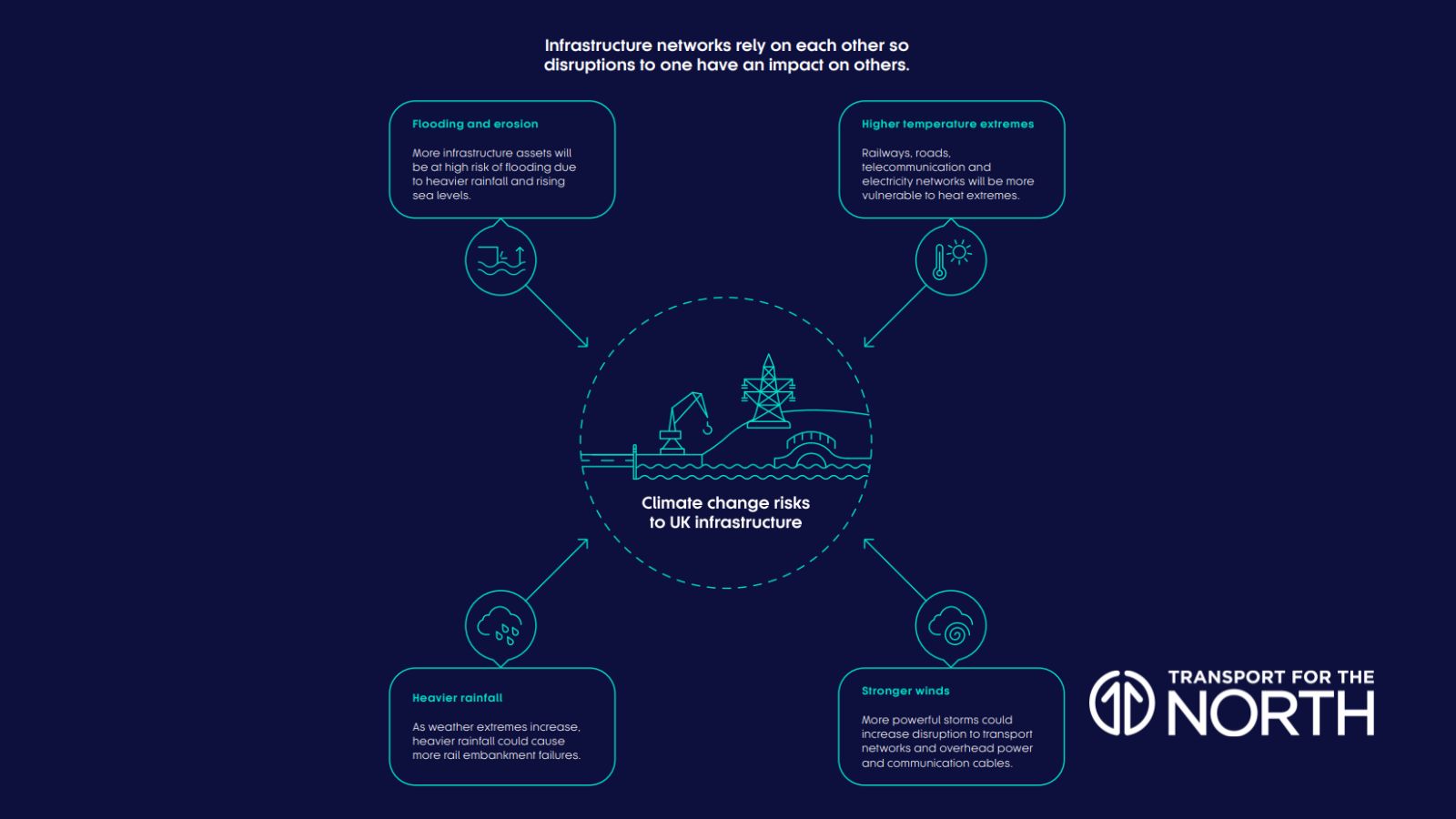
Infrastructure networks rely on each other, so, for example, you can’t just make your transport network more resilient if you haven’t sorted your energy transmission and telecoms resilience.
Climate change is the greatest challenge the human race has faced for centuries and something that should not be considered in isolation from the eco-systems within which,, and alongside which, we reside.
As a species we need to focus on the potential co-benefits of climate change adaptation – and particularly those associated with nature-based solutions.
The benefits of developing climate change adaptation measures, particularly nature based solutions, are often not limited to increased resilience to climate change effects. If planned and delivered in the right way, potential co-benefits include:
So, all in all a bit of a win-win then.
In the rail-space, we’ve seen what happens when our network is impacted by extreme weather – flooding, landslips, infrastructure damage and more and more evidence mounting that the network we have is not now capable of handling the events we now seem certain to have to face on a regular basis.
Transport for the North has already evidenced that a reliable rail network is fundamental to maintaining social cohesion and competitive levels of productivity which can build on clusters of talent.
We know too that rail, at least while we are still largely dependant on the internal combustion engine, is usually the most carbon-friendly option for mass transit into and out of our urban centres.
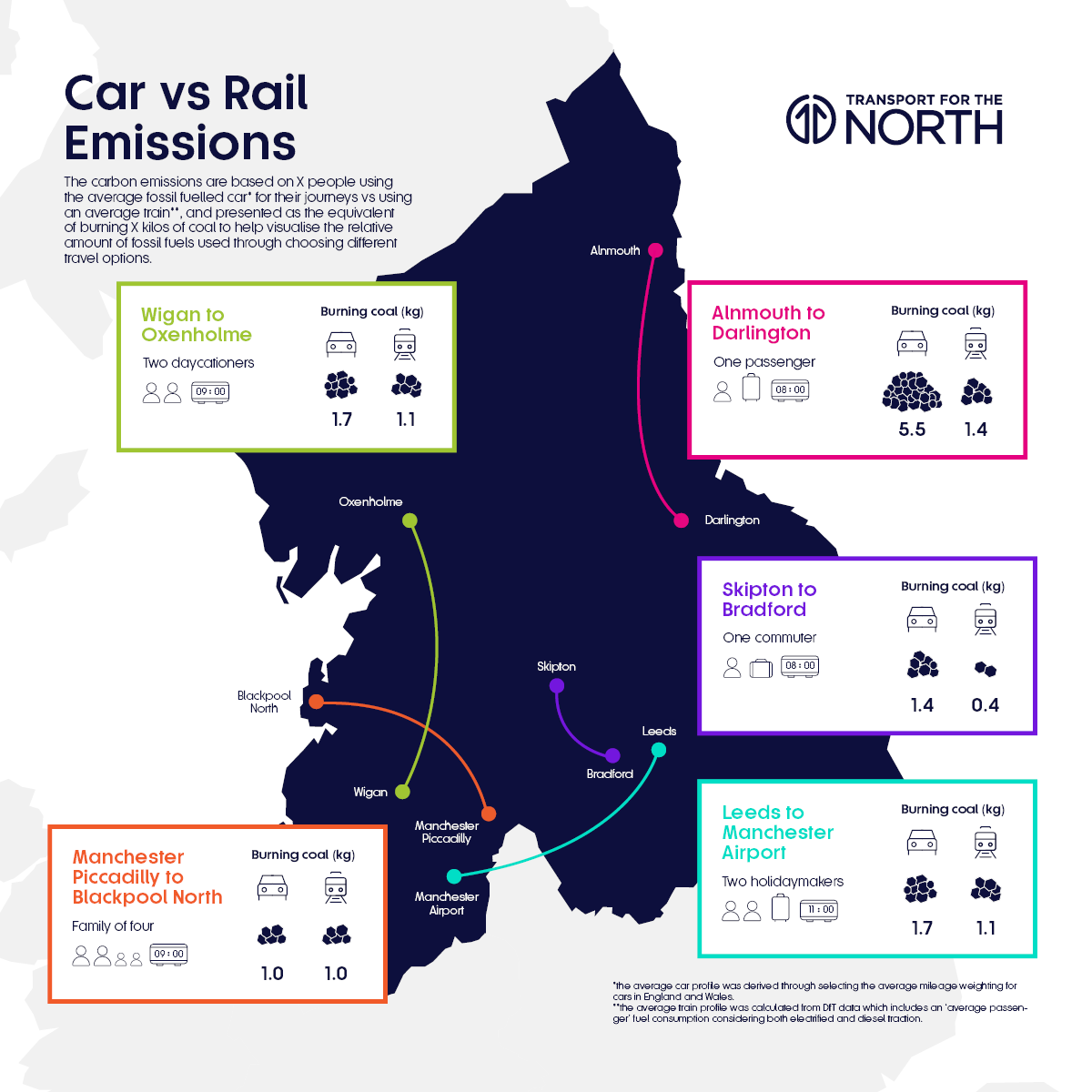
Our Technical Assurance, Modelling and Evaluation team (TAME) recently did some research comparing a variety of journeys across the North comparing a representative train with a representative average fossil-fuelled car.
The results confirmed, as you can see above, that a very significant reduction could be made in people’s carbon footprint if they simply stepped out of the car and instead boarded a train.
As our Chief Executive Martin Tugwell said: “Transport related social exclusion, for example, may sometimes mean limited or no choice in the way people travel.
“But it’s clear from the data, that, where it is possible, stepping out of the car and onto a train could make a significant impact on the North’s carbon footprint.
“To be a viable alternative to diesel or petrol car travel, though, the train and other travel options need to be accessible, affordable and reliable and we need to make the right investments to ensure this can be the case.
“Exploring and developing how best we can do this has to be a priority for both the North and the wider UK.”
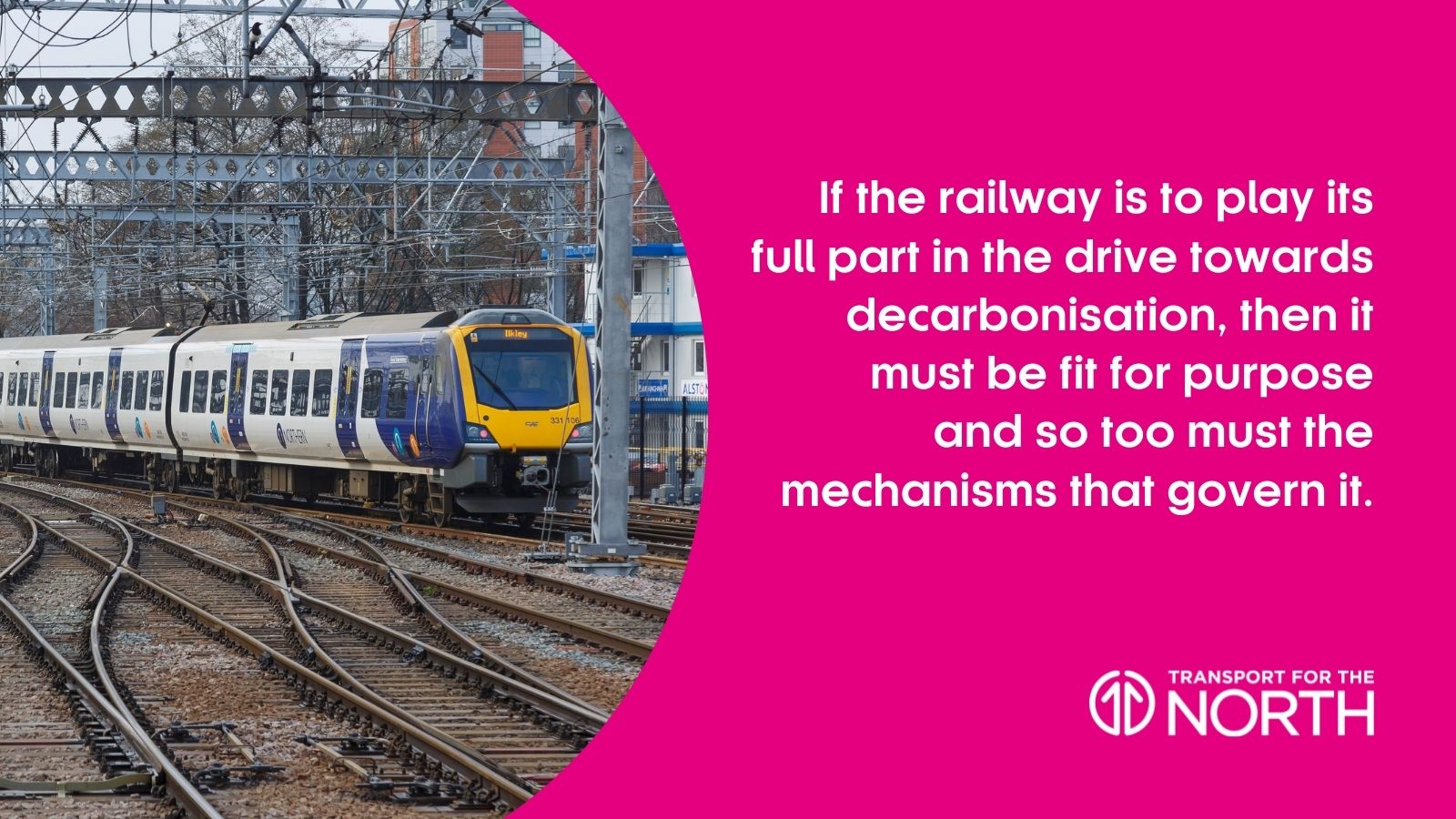
We have been working closely both with our local authorities, with Network Rail, with the train operating companies, and with the Department for Transport to see how we can play our part in improving the rail offer for the region – and in recent months we have seen some significant progress around joint initiatives that could improve outcomes for all of us in the North.
If the railway is to play its full part in the drive towards decarbonisation, then it must be fit for purpose and so too must the mechanisms that govern it.
Indeed ensuring the right hand and the left hand are joined up has been one of the biggest challenges across the industry and the impact of not being joined up has led to some spectacular failures.
So, it is now widely accepted that we need to bake in a governance structure that ensures rail interventions remain in lockstep with each other – something still being wrestled with at both the macro and the micro level.
At the micro (everything is relative!) level, the Manchester Recovery Task Force Blueprint is a prime example of what can be achieved when joined-up thinking and behaviours preside. Rail infrastructure and service enhancements are now being locked together as part of a single programme and the template for this is now also being used to tackle the challenges around reforming the East Coast Mainline timetable.
What these initiatives should ensure is: a) money is not wasted on initiatives that risk stalling because they clash; and b) outputs are optimised throughout the intervention process.
At the macro level, Transport for the North has been a key player in helping shape the model for the new Great British Railways, working closely with the GBR Transition Team and Network Rail on building a template that will allow the desired outputs evidenced in the Williams-Shapps White Paper to be realised as the new organisation comes on stream in the mid-Twenties.
Within Transport for the North, my colleagues in our Strategic Rail team have also been engaging with some of the more granular elements of helping make the region’s railways work better. We’ve been taking a close look at performance and reliability – both key issues of debate in the North – and we have also been looking at what’s needed for a resilient railway, one capable of withstanding some of the climate challenges that are now becoming the norm.
The table below shows some of the climate related challenges faced by the railway:
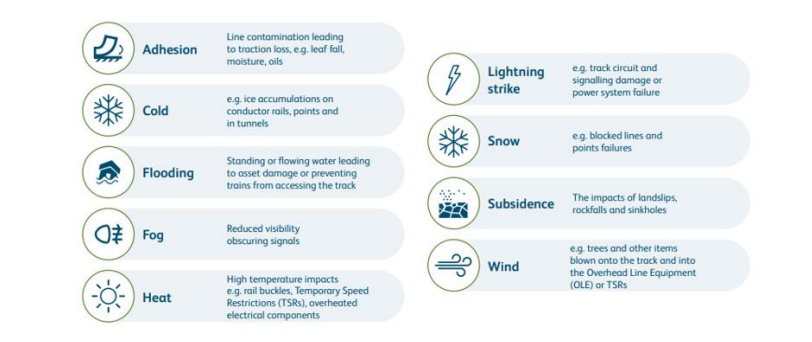
In the longer term, Network Rail’s vision for a resilient railway is for:
In the shorter term, their focus is to:
As part of its role, Transport for the North will engage with the two Network Rail regions, NW&C and LNE, to discuss and track progress of the individual Route Weather Resilience and Climate Change Adaptation (WRCCA) plans and provide updates to stakeholders affiliated to TfN.
Crucially, TfN will also make the link to local authorities where gaps in approach are identified or suspected to ensure the industry and neighbours are working together to tackles these issues.
This could include issues such as ensuring the local authority have taken account of the impact of their policies and land developments on their adjacent railway neighbour, where they may not already be obliged to do so under legislation.
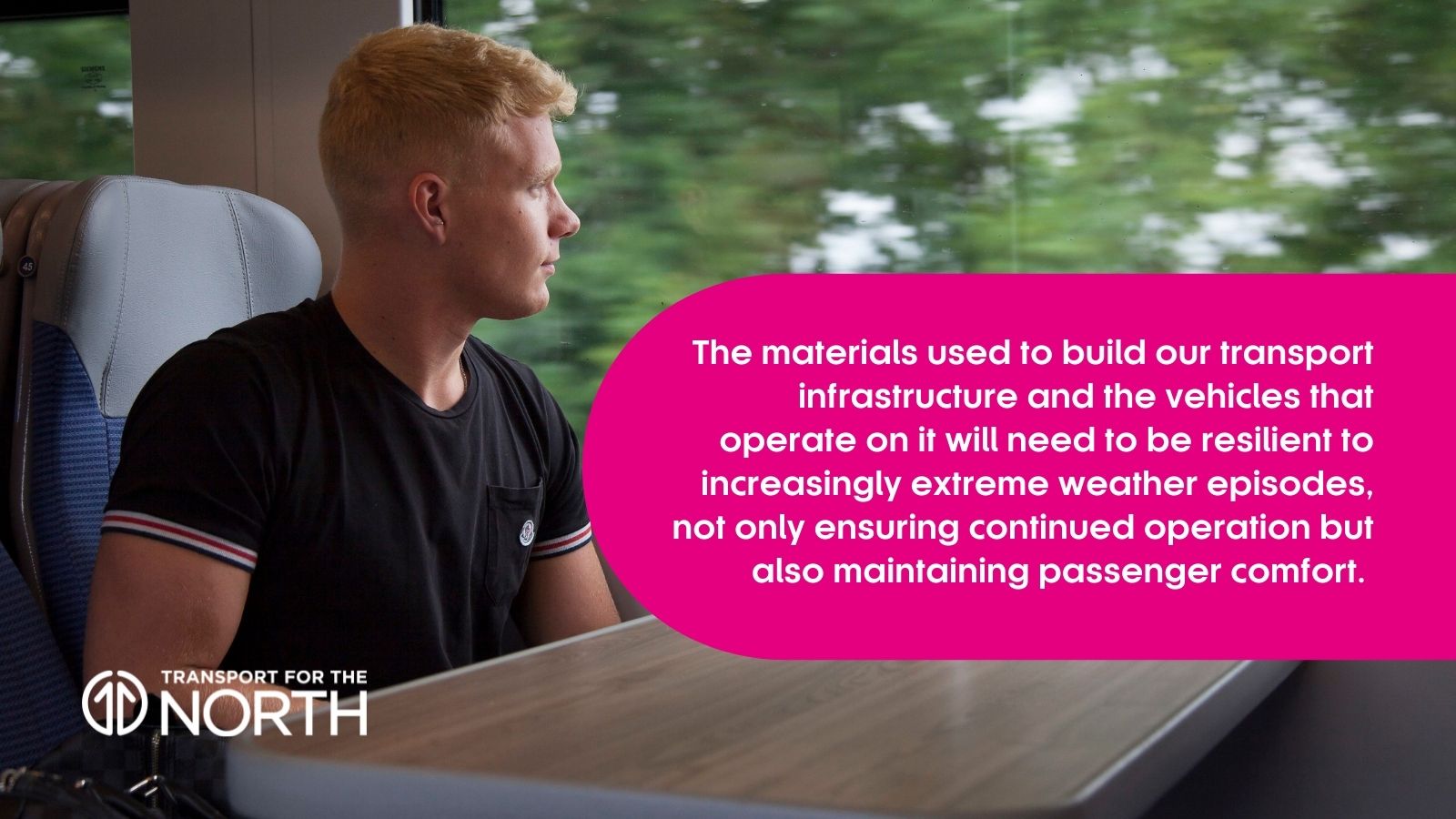
As we said in our Decarbonisation Strategy report: the materials used to build our transport infrastructure and the vehicles that operate on it will need to be resilient to increasingly extreme weather episodes, not only ensuring continued operation but also maintaining passenger comfort.
There is a need to identify how existing assets can be upgraded as well, such as employing cooling technologies and alternative insulation for rail stations and the removal of jointed track and obsolete fastenings to make rail tracks more resilient.
Tackling the climate emergency is a critical challenge, and the North of England has an important role to play. Working together, as outlined above, will be fundamental to securing the outputs we all need.
One thing is clear: we believe our region can, and must, take clear and comprehensive action to decarbonise surface transport over the coming years.